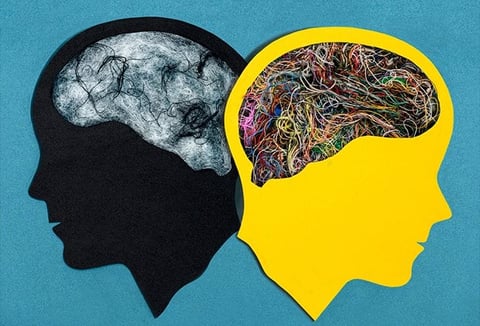Multiple Personality Disorder
SCIENCE
Arjun Prabhakar
12/16/20244 min read


Multiple Personality Disorder (MPD), now more commonly referred to as Dissociative Identity Disorder (DID), is a mental health condition characterized by the presence of two or more distinct personality states or identities within an individual. These identities, often referred to as "alters," can have their own unique names, behaviours, memories, and even physical characteristics. DID is a complex and often misunderstood disorder, raising significant interest and questions among mental health professionals, researchers, and the general public.
Defining Dissociative Identity Disorder
DID is classified under dissociative disorders in the Diagnostic and Statistical Manual of Mental Disorders (DSM-5). Dissociation is defined as a separation or disconnection among thoughts, memories, surroundings, actions, and identity. For individuals with DID, this dissociation becomes so severe that it leads to the formation of distinct identities or personality states. These identities often emerge as a coping mechanism in response to extreme trauma, particularly during early childhood.


Symptoms and Characteristics
The symptoms of DID are diverse and can vary widely among individuals. The primary feature is the presence of two or more distinct identities, each with its own sense of self and control over the individual’s behavior. Other symptoms include:
Memory Gaps: Individuals may experience significant lapses in memory, often referred to as "blackouts," where they cannot recall events, conversations, or activities.
Identity Confusion: A person may feel uncertainty or conflict about who they are, leading to significant distress.
Behavioral Changes: Alters may exhibit different speech patterns, mannerisms, and preferences. For example, one alter might be left-handed while another is right-handed.
Depersonalization and Derealization: A sense of detachment from oneself or one’s surroundings is common.
Co-occurring Conditions: DID often occurs alongside other mental health conditions such as depression, anxiety, post-traumatic stress disorder (PTSD), and substance use disorders.


Causes and Risk Factors
The exact causes of DID are not fully understood, but it is strongly associated with severe and chronic trauma, especially during early childhood. Commonly reported experiences among individuals with DID include physical, emotional, or sexual abuse, as well as neglect or exposure to violence. These traumatic experiences disrupt the normal integration of identity and memory, leading to dissociation as a protective mechanism.
Other potential risk factors include:
● Genetic Predisposition: A family history of dissociative disorders or other mental health conditions may increase susceptibility.
● Cultural Influences: Cultural and societal beliefs about possession or spiritual experiences may influence how symptoms are expressed and understood.
Diagnosis and Misconceptions
Diagnosing DID can be challenging due to its overlap with other mental health conditions and the stigma surrounding it. Mental health professionals use comprehensive interviews, psychological evaluations, and detailed patient histories to identify the disorder. Key diagnostic criteria include the presence of distinct identities, recurrent gaps in memory, and significant distress or impairment in daily functioning.
DID is often misunderstood and misrepresented in popular media, leading to numerous misconceptions. For instance, some believe that individuals with DID are dangerous or violent, which is not supported by evidence. Others doubt the validity of the disorder itself, viewing it as a fabrication. However, extensive research and clinical observations affirm DID as a legitimate and serious mental health condition.
Treatment Approaches
Effective treatment for DID involves a combination of psychotherapy, medication, and supportive care. The primary goal is to integrate the various identities into a cohesive sense of self or, at the very least, to improve communication and cooperation among alters. Treatment strategies include:
Psychotherapy:
○ Trauma-Focused Therapy: Helps individuals process and resolve traumatic memories.
○ Dialectical Behaviour Therapy (DBT): Teaches coping skills for emotional regulation and distress tolerance.
○ Cognitive Behavioural Therapy (CBT): Addresses distorted thoughts and behaviours associated with the disorder.
Medication: While there is no specific medication for DID, antidepressants, anti-anxiety medications, and antipsychotics can help manage co-occurring conditions like depression or PTSD.
Support Groups and Peer Networks: Building connections with others who share similar experiences can offer reassurance and help alleviate feelings of isolation.
Stabilization Techniques: Grounding exercises, mindfulness practices, and stress management strategies are essential for maintaining stability and reducing dissociation.
Challenges in Treatment
Treating DID is a long-term process, often requiring years of therapy. Some of the challenges include:
● Resistance to Integration: Some alters may resist integration due to fear of losing their identity or purpose.
● Comorbid Conditions: The presence of other mental health issues can complicate treatment.
● Stigma: Social stigma and skepticism can discourage individuals from seeking help.
Raising Awareness and Reducing Stigma
Promoting awareness about DID is crucial to reduce stigma and improve access to care. Public education initiatives, realistic portrayals in media, and open dialogues about mental health can challenge stereotypes and promote better understanding. Mental health professionals and advocates are instrumental in establishing a supportive environment where individuals with DID feel acknowledged and secure.
Conclusion
Dissociative Identity Disorder represents a multifaceted and frequently misunderstood mental health issue that originates from significant trauma. While challenging to diagnose and treat, individuals with DID can lead fulfilling lives with the right support and therapeutic interventions. By fostering awareness and understanding, society can help create a more inclusive environment for those living with this condition. Continued research, education, and advocacy are essential to unravelling the complexities of DID and improving outcomes for affected individuals.
